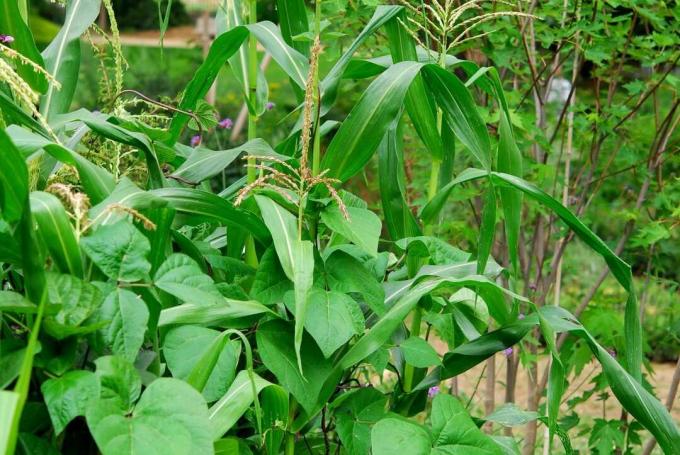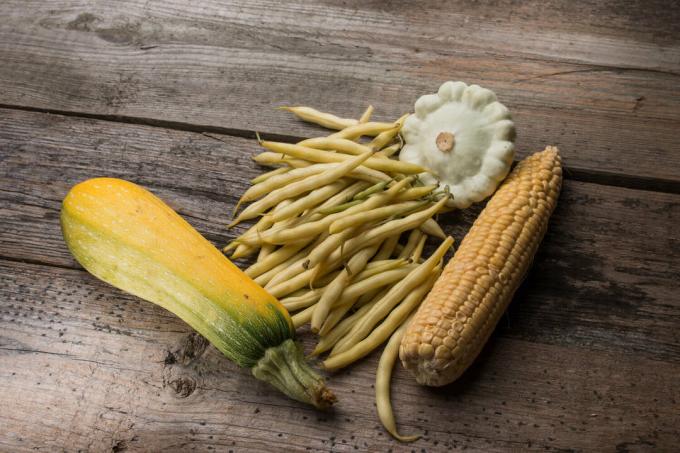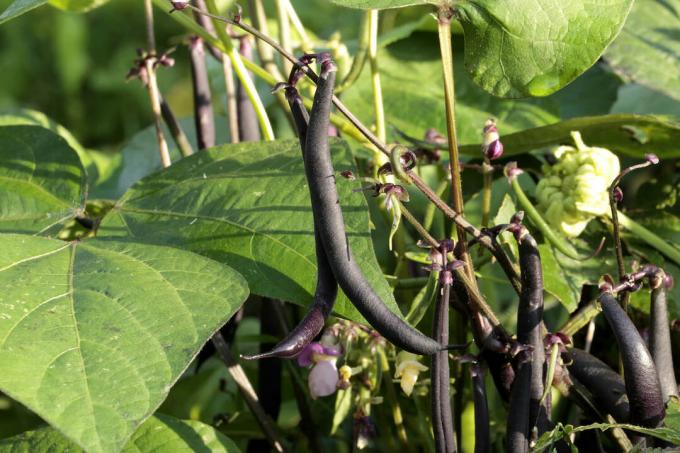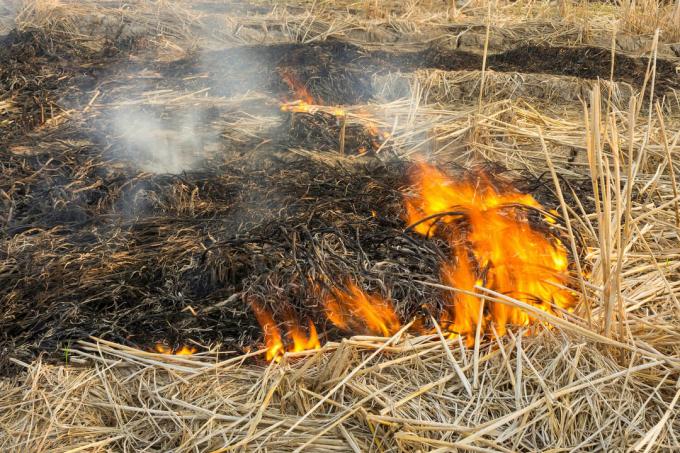Even the Maya were aware of the importance of mixed culture. One cultivation system that has persisted over the centuries is the so-called milpa: corn, beans and pumpkin are grown in one bed.

A South American cultivation system that should work here in Germany? The mixed culture partners maize (Zea mays), Bean (Phaseolus vulgaris) and pumpkin (Cucurbita spec.) are also classics with us that are grown frequently. However, we can learn from the indigenous peoples of South America how well the three cultures fit together and complement each other. This is also made clear by the English name "Three Sisters". In this article you will learn what Milpa is all about and how you can easily create a Milpa bed in your garden.
contents
- Milpa-Beet: what is it?
- What are the advantages of a Milpa bed?
- Creating a Milpa bed: step by step
- Proper care
Milpa-Beet: what is it?
The word Milpa means something like "the near field". It can be traced back to the fact that the Mayan Milpa fields were actually close to their homes. Milpa means that corn, beans and pumpkin are grown together in the same field and complement each other. The aim is to achieve a rich harvest and healthy plants. The three sisters used to ensure the basic supplies of the indigenous peoples: maize is a Energy-supplying grain that can be stored for a long time and for making tortillas and the like was used. Beans, on the other hand, are important sources of protein and pumpkins contain other vitamins and minerals.

What are the advantages of a Milpa bed?
The three mixed culture partners maize, bean and pumpkin support each other. The maize as the main crop also serves as a climbing aid for the beans. Since beans are legumes, they enter into a symbiosis with nodule bacteria. These then fix the nitrogen from the air, which supports the growth of the beans and, in the long term, fertilizes the soil through the rotting of the plant remains. As the third partner, the pumpkin covers the ground with its large leaves, which suppresses the growth of unwanted weeds and keeps the ground moist by providing shade.
Further advantages of a Milpa bed are the efficient use of space, which enables high yields on a relatively small area, and the low maintenance effort. As soon as the ground is covered by the pumpkin, the bed is more or less visible to itself. This is why weeding, for example, is only necessary at the beginning of the cultivation.
Creating a Milpa bed: step by step
A Milpa bed can be created in many different ways, so that after an initial research you can be overwhelmed with the many possibilities. With our step-by-step instructions, nothing stands in the way of successful cultivation.
1. Area selection: For a Milpa bed, you should choose a piece of your garden that is at least 1.20 mx 2 m in size and that gets plenty of sun. In addition, one should keep in mind that the mixed culture grows very high. So it can easily happen that other crops are shaded in the garden.
2. Improve soil: All three cultures prefer a humus soil that stores water well. If you want to prepare your garden soil well for cultivation, you can use a nutrient-rich soil, such as ours Plantura organic compost or work in some compost of your own.
3. Select the mounting system: In South America the Milpa is typically designed in clumps. That means, for example, you plant three corn and two bean plants close together and the pumpkin at a certain distance from them. Alternatively, a Milpa bed can also be laid out in rows. The maize is grown with a row spacing of 60 to 80 cm and a planting distance within the row of around 40 cm. You sow up to three beans around each corn plant. Finally, between the rows of maize, there is the pumpkin, with a distance of around 2 m between the individual plants.

4. Select varieties: The choice of variety is crucial for a successful Milpa culture. Above all, the composition of corn and beans has to be right. For example, if you combine a strong-growing bean with a rather slow-growing maize, it can quickly happen that the bean overgrows the maize and literally wrestles to the ground. In the case of beans, it is also advantageous to choose a colorful variety. These can later be found more easily in the thicket of the Milpa bed than green beans. We have put together some good combinations for you in the table below.
| Maize variety | Type of bean |
|---|---|
| 'Black Aztek' | 'Goldsfield', 'Green Post Squirrel' |
| 'Golden Bantam' | 'Scarlett Emperor', 'Sunset' |
| 'Rainbow Inka' | 'Striking' |
| 'XT Goldcrest' | 'Neckargold', 'Neckar Queen' |
| 'SF 201' | 'Markant', 'Matilda', 'Flavourstar', 'Musica', Blauhilde |
5. Prefer corn and possibly pumpkin: Maize has slow youth development and in our part of the world cannot be planted until mid-April at the earliest. Therefore, it makes sense to bring it forward in the house from March. Give each maize plant its own pot right from the start, as young maize plants have strong roots and prick out is difficult. When planting pumpkin, you have two options: it can either be brought forward from April or sown directly with the beans in May.

6. Planting and sowing in May: In mid-May, the self-grown or purchased young plants can move into the bed. The planting distances as described under point 3 should be adhered to. At the same time as planting the corn and pumpkin, the beans can also be sown about 5 cm deep in a circle around the corn plants.
Proper care
At the beginning it may be necessary to keep the soil free of weeds by hand. But once the plants are big enough, even a bit of weeds won't bother them and you can leave the bed to itself. If everything went well, a wild, green and yet fertile jungle has emerged from around July. Of course, the three types of vegetables need enough water, so that regular watering is essential, especially with increasing dry periods. Pumpkin and corn in particular have a high demand for water from flowering and if the supply is too low, the cobs and fruits remain small.
If the three sisters are grown in a fertile, well-prepared field, there is usually no need to fertilize. In South America, Milpa is usually only intensively farmed for three years, followed by ten years of fallow. Because especially corn and pumpkin are among the heavy eaters. Another common practice in South America is slash and burn. This brings nutrients and organic matter back into the soil. Since this is not possible with us, you can simply compost the plant residues directly on the area as mulch and submerge it in the spring before the next planting.

Tip: You can even start a small Milpa culture in a large bucket on the balcony or terrace. To do this, choose a small corn, such as the ‘Supai Red’ variety, of which four to five plants are planted in the middle of the tub. There are four French beans in a circle on the outer edge of the bucket. A small pumpkin is placed between the corn and beans. A nutrient-rich soil, such as ours, should be used as a substrate Plantura organic compost, be used. It is completely peat-free and therefore more sustainable than many common potting soils.
If you want to learn more about growing different plants in one bed, you can read our article on Mixed culture Continue reading. There you can find out, for example, why tomatoes and basil go well together not only on the plate, but also in the bed.
